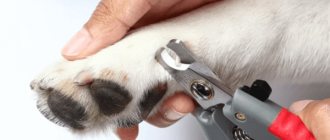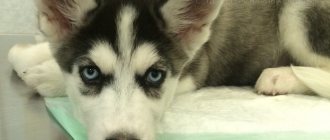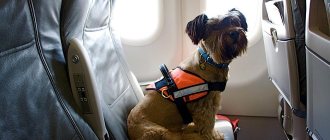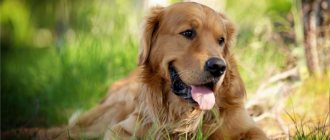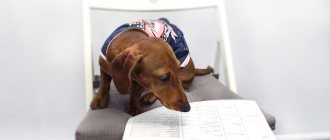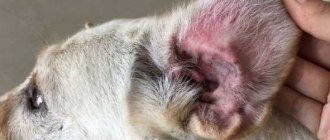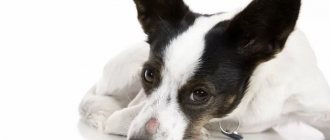Dog owners know that their pets' nails need to be kept in order and trimmed regularly, but no one is immune from troubles, as well as from injuries. Removing a dog's claw is a full-fledged operation that is performed sterilely under full anesthesia and only for medical reasons.
Dog declawing is not practiced to satisfy requests for the convenience of owners or the safety of other animals. The structure of a dog's paw is such that when walking, running and maneuvering, the claws act as additional support. Simply put, without claws, the animal will either not run or will fall.
Dogs use their claws to dig the soil, this is especially pronounced in burrowing and hunting breeds. Claws are a tool of protection in a fight, which is also important. From the owner's point of view, dog claws are the cause of scratches and torn bags. But if you love a dog, then you need to educate it, or accept the inconvenience.
Declawing is carried out only for medical reasons:
- Injuries
– while playing or on a walk, a dog can tear a claw. Having received such an injury, the pet experiences severe pain and loses a lot of blood. Depending on the extent of the lesion, the claw may be completely or partially removed. - Inflammations
- splinters, cuts and other injuries can lead to suppuration in the pad or the finger itself. The difficulty is that the dog’s paws are constantly moving and do not heal well. If the infection is ignored, it spreads into the deep tissues. Depending on the depth and extent of the inflammation, the dog's claw or toe will be removed. - Frostbite and burns
are the main danger of such injuries; this is the cessation of blood circulation in the tissues. After receiving frostbite or a burn, literally in a matter of hours, the tissues die (necrotic process). The threat is sepsis, that is, blood infection that spreads pathogenic cells throughout the body and organs. Typically, patients with such injuries are observed for 24 hours; if intoxication or progression of necrosis is observed, the entire affected area is cut off. - Gangrene
- without going into details, the process is similar to necrosis, which is actively progressing. By the way, gangrene can occur as a consequence of frostbite. - Irregular growth
of claws and fused claws. - Ingrown claws
.
For osteosarcoma and other oncological processes
, bone delamination occurs. Quite often the process begins in the fingers. The dog is in pain, it spares its paws, runs less, and at this time the claws grow back. If the owner does not notice the deviation in time, sooner or later, the pet will tear off the claw. Having arrived at the doctor with an injury, the dog is sent for an x-ray (according to the protocol). The picture shows that the bones are stratified, that is, an oncological process is underway. If you start treatment at this stage (there are no metastases yet), that is, cut off the finger and claw and carry out radiation therapy, there is a high chance of stopping the development of oncology.
Reasons for wolf claw removal
Some dogs, including purebred ones, have a fifth toe with a claw on their hind and front paws. This feature is considered vestigial, that is, inherited from wild ancestors, and is called the “dewclaw” or “wolf claw.”
For many years in a row, dewclaws have been removed from almost all show dogs. For some native breeds, they are acceptable and even desirable, but they are a minority.
Recently, studies were conducted that included several large control groups of tetrapods. Based on the results of observations, it turned out that most dogs with dewclaws actively use them while chewing bones and playing. Today, the removal of dewclaws is not prohibited, although it is condemned in countries with a developed legal system. According to the standard of most breeds, dewclaws must be removed.
Methodology
The method of performing the operation depends on the goals set. In any case, declawing surgery is a complex and painstaking process that requires:
- Compliance with septic and antiseptic rules.
- The doctor's experience.
- Availability of equipment, preferably a special cautery, which cauterizes the vessels during dissection.
- Preliminary examination of the dog for heart, kidney and liver diseases. At a minimum, a general blood test is taken and an examination is carried out.
- Full anesthesia, since the procedure is very painful, requires precision from the surgeon and immobility from the patient.
A dog that picks a nail will not necessarily lose it completely. The doctor’s task is to stop the bleeding, cauterize all the vessels, and preserve the claw and finger as much as possible. If everything goes well, the tailed one will need rehabilitation and care, but a new claw will then grow. The recovery process is quite long, but after the wounds heal, the dog does not experience much discomfort.
In other cases, when it comes to
saving a limb or the life of an animal, the claw is removed forever.
If the damage affects the finger, it will also be amputated.
It is unwise to hesitate and take risks in such situations, since the remaining infection may rise higher and then we will talk about amputation of a hand or limb.
How to trim nails correctly
Trimming claws as a procedure is not a difficult matter; all the difficulties lie in correctly determining the location of the cut. It will be especially difficult for owners if their pet has black or very dark claws. The denser and darker the color of the claw, the less visible where the blood vessel begins. First, examine the nail against the light (a flashlight or a bright lamp); if the blood vessel is visible, half the job is done.
The fact is that the blood vessel is gradually drawn deeper into the claw (if the claws are trimmed regularly). A safer option that allows you to gradually shorten a blood vessel is filing, but not all dogs are indifferent to this procedure even after training.
During the procedure, you need to maintain maximum hygiene. Wash your pet's paws and hands. Be sure to treat the nail clipper, even if it is new and just out of the package. Do not treat paws, fur or claws with antiseptics - this will do no good, and the strong smell will agitate the dog. Just in case, keep a first aid kit and a blanket on hand to wrap your dog in. If you are unsure of your pet's tolerance, then prepare a separate first aid kit for yourself...anything can happen. It is advisable to treat bites and scratches until they bleed immediately; if there is no antiseptic on hand, a napkin soaked in saline solution (or a solution of 1 liter of water: 1 teaspoon of salt and soda) is placed over the injured skin.
Tip: start trimming with the front paws, as the dog will behave more calmly if the procedure is carried out in front of his eyes.
Try to speak as softly as possible, but act confidently. You should expect a jerk or resistance at any moment. For the first procedure, it is better to enlist help, since you will have a tool in one hand and a pet’s paw in the other. If your dog pulls his paw out, it's not so bad, because in the worst case, you simply won't trim the nail. It is dangerous if the pet leans forward, you will cut off more than necessary.
Tip: to be sure, it is better to put a collar and a fixed leash on your pet.
Even if you hurt your pet, it is important to hold him for help.
To determine the location of the cut, the claw must be examined from the side. In quadrupeds with light-colored claws, the blood vessel is clearly visible. In dogs with long fingers, there are small grooves on the sides of the claws, which are also convenient for navigation. The blood vessel itself is insensitive, but the nerve endings that approach it react sharply even to temperature fluctuations. Please note that after cutting the claws, you need to file them down, that is, you need to leave a little extra keratinized tissue.
Tip: Don't rely on manuals, but watch your dog. According to generally accepted rules, the claws are first trimmed and then filed. However, the experience of owners has shown that some pets like to “rest” a little between cutting each claw.
The sensitivity of the claws is very individual, it can be compared to the sensitivity of people’s teeth - some people don’t know what it is, while others suffer all their lives. Until you get the hang of it and your pet is not used to the haircut, it is better to cut off a very thin layer of keratinized tissue, but carry out the procedure more often.
After trimming and filing, run a napkin or cotton sponge over the nail. The claw should be smooth and without burrs. Do not try to cut all the claws at once, especially if the procedure is being performed for the first time. As soon as your pet starts to get nervous, take a break and return to grooming after 30-60 minutes or even the next day. The most important rule is to praise the dog for each nail trimmed, but do not feel sorry for it. With regret and worry, you let your pet understand that he needs to be afraid of trimming his nails, that you are also afraid, which means that it is really scary.
Post-operative care
The operation to remove a claw is very painful and requires long-term rehabilitation. At the junction of the claw and finger, there are a large number of nerve bundles. To alleviate the condition, the animal is constantly administered painkillers, non-steroidal anti-inflammatory drugs and antibiotics.
A tight bandage is applied to the paw from which the claw has been removed.
, which changes once every 1–2 days. During dressing, the wound is disinfected and lubricated with healing preparations.
When the incision site is initially scarred, the bandage is removed, but a surgical collar is placed on the dog.
. At this stage, the owner must pay special attention, since there is a high risk of injury. Follow-up treatment is carried out after each walk. The collar continues to be worn until the wound is completely healed.
Suddenly you notice blood on your dog's paw, he limps and licks his paw. Upon examination, the cause becomes clear - a damaged claw. Nail problems, especially pulled or broken nails, are common in dogs and are rarely life-threatening. However, it is usually very painful.
Nails often get caught in fabric or carpets, and in an attempt to escape, the dog can injure or pull out the nail. You may not notice it until there is blood or the dog starts limping or whining. Without treatment, an injured nail can bleed periodically and become infected, not to mention causing pain and discomfort for your dog.
Signs that a dog has a broken nail
The injury received by an animal, as a rule, does not go unnoticed by attentive owners. The animal, which previously ran carefree during a walk or indoors, begins to limp. The dog tries not to step on the injured limb and keeps it suspended. Many individuals try to lick the painful area. Due to the fact that animal claws are equipped with blood vessels, their damage is most often accompanied by bleeding.
Upon visual inspection, the owner will find that the nail is either broken or completely torn out from the nail fold. The damage should be examined very carefully, as the slightest touch brings severe pain to the pet.
Veterinary assistance
Some dog nail injuries can be treated at home if your dog allows it, but veterinary treatment can reduce the chance of infection and also make the damaged nail easier to remove. Depending on the extent of the damage to the claw, removing the claw is often sufficient. The easiest way to do this is with a nail trimmer. After removing the broken part, your veterinarian may apply a temporary bandage to stop the bleeding. He may also prescribe an antibiotic to rule out infection.
Prevention of nail damage in dogs
Considering the prevalence of the problem, orthopedic veterinarians and experienced dog breeders recommend that owners of four-legged friends adhere to the following rules for care and maintenance:
- Trim overgrown nails regularly. The overgrown stratum corneum clings to hard surfaces and sooner or later will lead to injury. Neglecting this simple hygiene procedure will protect your dog from painful injuries.
- The manipulation should be carried out using a special tool for trimming animals. The nail clipper should be made of high-quality metal, which will prevent the occurrence of hangnails and delaminations when trimming the nail. Particular attention should be paid to additional claws, which, due to their physiological characteristics, grow faster.
- The animal's diet must be balanced in nutrients, vitamins and microelements.
- In winter, when keeping dogs in heated rooms, it is recommended to humidify the air using an air conditioning system and sprayers.
We recommend reading about eye injury in dogs. From the article you will learn about the causes of eye injuries in dogs, types of injuries, diagnosis of the condition of the cornea and other parts of the eye, and treatment.
And here is more information about how to treat a dog’s wound.
A broken claw can cause serious problems for your four-legged friend in the form of bleeding and pain. The owner’s task is to be able to competently provide first aid to the animal and deliver it to the clinic as soon as possible. An examination by a veterinarian is necessary if there is bleeding from the wound, severe lameness and pain.
Treatment consists of complete or partial removal of the damaged nail, stopping bleeding and antiseptic treatment of the wound.
Home care
If you are trying to treat your dog at home, remember that an injured nail is painful for your dog and you should take care to avoid biting.
The following steps are important:
- First you need to stop the bleeding. You can use silver nitrate or a styptic pencil. You can use potassium permanganate crystals. If you don't have any of these, try starch or flour. Placing these substances on a bleeding claw should stop the bleeding.
- Removing a damaged claw is the most difficult stage. Often, the broken off part of the nail can be removed by hand, or you can use a dog nail trimmer and simply bite the nail where it was damaged. Remember that this will cause momentary pain to the dog. If the damage to the claw occurs very close to its base, then the trimmer should not be used; consult a veterinarian for treatment. The last bone of each finger is located very close to the beginning of the claw. Without the proper experience, you can cause much more harm to your dog than you think.
- If you have successfully removed the damaged part of the nail, gently rinse the area with warm water to remove any foreign particles between the toes. Then apply a temporary bandage if necessary to stop the bleeding. Try not to tighten the bandage too much so as not to disrupt the blood circulation in the paw. Leave the bandage on for 12 to 24 hours.
- If you feel unsure about caring for an injured nail, contact your veterinarian. Leaving an injured claw to heal on its own (which it won't) or waiting for it to grow back on its own is not a good option. This will cause discomfort in the dog and also provoke possible repeated injuries to the nail.
Do I need to remove the rudiments?
Dewclaws of the hind limbs are not considered a pathology and it is not necessary to remove them. Veterinarians recommend operating on puppies to avoid possible complications:
- injuries while walking, running;
- inconvenience in caring for the dog: cutting, combing; bathing;
- ingrowth of the nail into the skin.
It is mandatory to remove a finger in case of diseases of the dog’s paws. Such diseases include:
- necrosis – tissue death;
- osteosarcoma;
- gangrene;
- osteomyelitis;
- dewclaw injury.
There is also a group of dogs that will have to have their dewclaw removed:
- Hunting breeds. Due to the rudiment, it becomes difficult to move through thickets and forests. The fifth finger will simply cling to branches and grass, which can injure the animal.
- Show dogs. If a dog is being prepared for a show, then removal of the rudiment is mandatory during puppyhood. But there is an exception: it is forbidden for the Pyrenean Mountain Dog and Biard to remove the rudiment before the exhibition. The appearance of the 5th finger indicates their purebred.
Read What to do if your dog vomits white foam
To reduce the risk of injury, veterinarians recommend removing dewclaws from puppies under one week of age. During this period, the puppy will not feel severe pain, and the recovery process will go quickly.
Injuries
If suddenly your dog suddenly begins to limp or bend its paw under itself, then most likely it has suffered a nail injury. Often the dog clings to an object with its claw and, sharply trying to break away, injures it. If the situation is left untreated, the animal may become infected with the wound, not to mention intolerable pain.
Broken Claw
Dogs break their nails quite often.
If this happens to your pet, examine the nail to see if it is bleeding or not, if it is broken partially or at the root.
.
And then, based on a certain algorithm of actions, begin treatment.
Under the root
The wound should be washed with potassium permanganate or peroxide.
Then apply an antiseptic bandage to the paw. If the damage is very serious, contact your veterinarian.
Partially
Rinse the wound with peroxide or potassium permanganate, then treat the wound.
Then carefully trim the broken claw. At the end of the procedure, bandage the wound using an antiseptic, healing ointment (the bandage should be changed several times a day).
Every owner must take care of his pet and provide constant care for it. Check your animal regularly for various injuries.
Remember that you are responsible for your dog's life.
Suddenly you notice blood on your dog's paw, he limps and licks his paw. Upon examination, the cause becomes clear - a damaged claw. Nail problems, especially pulled or broken nails, are common in dogs and are rarely life-threatening. However, it is usually very painful.
Nails often get caught in fabric or carpets, and in an attempt to escape, the dog can injure or pull out the nail. You may not notice it until there is blood or the dog starts limping or whining. Without treatment, an injured nail can bleed periodically and become infected, not to mention causing pain and discomfort for your dog.
Care for dewclaws
If the breeder decides not to amputate the 5th finger of his pet, then he must properly care for him. All procedures are carried out in the same way as with the animal’s ordinary fingers: it is necessary to trim the claws in a timely manner and ensure that the dog does not injure the rudiment. But, if the claws grow incorrectly, dig into the skin, and cause discomfort to the dog, then veterinarians recommend thinking about the procedure for removing the dewclaw.
Read Signs and treatment of ataxia in dogs: 3 types of disease
Whether or not to amputate a puppy's 5th toe is the owner's decision. Before making a decision, the owner should think about the animal’s lifestyle: whether the owner can care for the 5th toe without injury. Grooming, bathing or combing the animal should be done with extreme caution. An extra finger should not interfere with walks and exhibitions.
Veterinary assistance
Some dog nail injuries can be treated at home if your dog allows it, but veterinary treatment can reduce the chance of infection and also make the damaged nail easier to remove. Depending on the extent of the damage to the claw, removing the claw is often sufficient. The easiest way to do this is with a nail trimmer. After removing the broken part, your veterinarian may apply a temporary bandage to stop the bleeding. He may also prescribe an antibiotic to rule out infection.
Home care
If you are trying to treat your dog at home, remember that an injured nail is painful for your dog and you should take care to avoid biting.
The following steps are important:
- First you need to stop the bleeding. You can use silver nitrate or a styptic pencil. You can use potassium permanganate crystals. If you don't have any of these, try starch or flour. Placing these substances on a bleeding claw should stop the bleeding.
- Removing a damaged claw is the most difficult stage. Often, the broken off part of the nail can be removed by hand, or you can use a dog nail trimmer and simply bite the nail where it was damaged. Remember that this will cause momentary pain to the dog. If the damage to the claw occurs very close to its base, then the trimmer should not be used; consult a veterinarian for treatment. The last bone of each finger is located very close to the beginning of the claw. Without the proper experience, you can cause much more harm to your dog than you think.
- If you have successfully removed the damaged part of the nail, gently rinse the area with warm water to remove any foreign particles between the toes. Then apply a temporary bandage if necessary to stop the bleeding. Try not to tighten the bandage too much so as not to disrupt the blood circulation in the paw. Leave the bandage on for 12 to 24 hours.
- If you feel unsure about caring for an injured nail, contact your veterinarian. Leaving an injured claw to heal on its own (which it won't) or waiting for it to grow back on its own is not a good option. This will cause discomfort in the dog and also provoke possible repeated injuries to the nail.
Trimming process
Having prepared the instrument and calmed the animal, you can begin the procedure. It is very important for the owner to know how to trim a dog's nails. There are a few things to consider during the process:
- First you need to determine the location of the cut. It is important here not to touch the living part of the claw. If the claw plates are light in color, then this area is a pinkish stripe at the center of the claw. For dark dogs, everything is more complicated - you just have to avoid cutting your nails too short.
- You need to cut at an angle of 45°. In this case, they remove it a little at a time, 0.5 mm at a time, so as not to touch the blood vessels.
- When performing the procedure, you should not touch the area between the claws. This tickles the animal and the pet will struggle.
- Do not squeeze the dog's paw too hard, otherwise the animal will try to run away. The pet must understand that you do not want to harm it. Let your movements be confident, but careful.
- To trim a dog's hind paw nails, the animal is placed on its side. Some owners use someone else to help hold the dog during the procedure. It is very inconvenient to do this alone: if the animal twitches and tries to run away, it can injure itself.
This is a short guide on how to trim your dog's nails at home.
Prevention
Claws are a fairly important part of a dog’s body. They protect the paw pads, help hold objects and protect themselves, and provide traction. Therefore, among such injuries as paws, broken claws are the most common.
And the owner needs to know well what to do in a situation where the dog breaks a claw.
You can notice a dog's broken claw by the fact that the dog suddenly limps. She may also lick her paw and refuse to run. If you notice this behavior, you need to carefully examine your dog's paws. If a torn or broken claw is noticed, you need to assess the extent of the damage.
